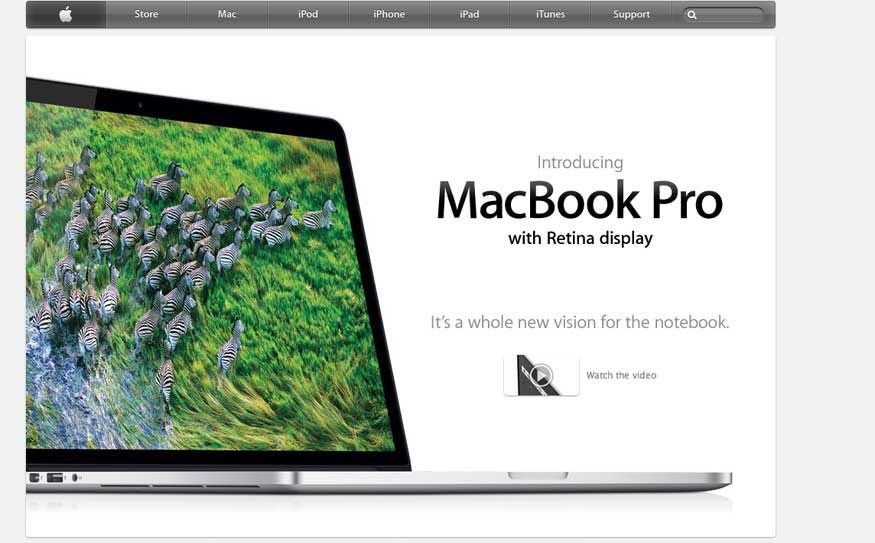There's a photo circulating the web of the new MacBook Pro (MBP) being unveiled at the World Wide Developer Conference hosted by Apple last week. It depicts the 15-inch laptop in a circular glass case, surrounded by roughly 200 photographers with very serious, completely awed looks on their faces.
If nothing else, the photo shows that the Cult of Mac is still very much alive since the passing of Steve Jobs, and how everything the Apple does is important, international news. Even the introduction of a new asymetrical fan — basically a normal fan with different shaped blades placed irregularly to cut noise — got rave reviews, even if it's nothing special and not entirely original.
Like everything Apple does, the technology news media went ape over the new device, which is on sale now.
In a way the media circus is understandable. It's an impressive machine and the first laptop with a full retina display — 2880 by 1880 pixels packed into a 15-inch screen. It's extremely light, at about two kilos (4.5 pounds), and boasts a fast, energy-efficient Intel 2.4 GHz Core i7 and a dedicated Nvidia GeForce GT 650M graphics processor. It uses flash (solid state drive) SSD storage, which makes it faster and cuts down on power consumption.
It's understandable if that glass case at WWDC got a little drool on it. The truth is, there's never been a laptop like this.
But should you care?
My own early assessment is no, unless you're a wealthy gearhead and a card-carrying Apple cult member. First of all, it's extremely expensive. The most basic 15-inch model weighs in at $2,200 — enough to buy three relatively high-end 17-inch laptops from another company. If you max out the specs for memory, storage, etc. then you're looking at $3,750 for a model with a 2.7GHz processor, 16GB RAM, 768GB of SSD storage.
The basic model comes with 8GB of memory, which is not expandable as the memory chip is soldered directly to the motherboard. That's important: you can never repair or upgrade the RAM in this machine. If you think you'll ever need more than 8GB you have to make that investment at the time of purchase, or forever hold your peace.
As well, the battery is glued into the case. Given that batteries do die or lose their charge after time, it was a strange decision on Apple's part.
As was the fact that the screen cannot be repaired or swapped out if it's cracked or damaged. The 256GB SSD hard drive — seriously, that's all you get with the basic model — also can't be expanded. It maybe possible to swap out storage in the future with aftermarket parts that fit the space, but right now it's an all-or-nothing decision.
At iFix.com, the online DIY website, they gave it a 1/10 in reparability, calling it the least "least repairable" laptop of all time.
There's also no Ethernet jack, which means wireless connectivity only — something that's not available, or practical, at a lot of workplaces that worry about security and insist everybody connects through the LAN.
Wireless is also slower, and while speeds are improving there's nothing faster than being hard-wired to your modem. If you have an electromagnetic sensitivity or are trying to reduce wave radiation in your home, this is not the laptop for you. An ethernet port is an odd thing to leave out, and will turn off business and enterprise users.
There's no optical drive either, which can be an issue if you back up files to disk, keep disk archives or buy software in disk form. You can't even transfer your old CDs onto this computer unless you buy an external drive.
The online debate over this computer is almost as insane as the amount of media attention it received.
One area of debate is what the retina display will ultimately mean. Yes, it will be great for photographers and graphic artists, no question, and it works well with software optimized for the retina displays on iPhones and iPads — but it doesn't add a lot to everyday activities like word processing or web browsing. Aside from Apple software, most third-party software is not (and won't be) upgraded to fit the screen simply because retina displays will be a silver of the total market.
A tech writer was ridiculed for suggesting that this computer will increase your bandwith usage, something Canadians with bandwith limits should be concerned about, but he was right. For example, a lot of websites populate their pages based on what computer or browser you're running, and when they detect that you have a high-definition display they automatically present you the larger image rather than upscaling a lower resolution image to fit your page. That takes more bandwith.
As well, with that many pixels, it's doubtful that standard definition movies will look all that good. They will either be too small to see or will be too blurry after being upscaled. As a result, MBP users are generally going to select the HD video option every time, which requires more bandwith.
Personally, I always select standard definition videos because they look fine on my computer, load faster, stream smoother and use less of my limited bandwith. If I'm ordering a movie from the Zune Marketplace or Rogers on Demand, standard definition is generally cheaper as well.
But if you're seriously thinking about spending $2,200 on a laptop, money probably isn't an issue for you. And if it is, you can probably do better than the MBP.




